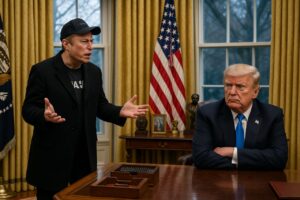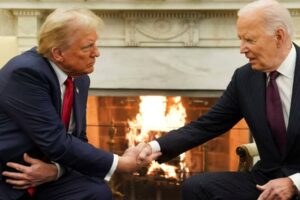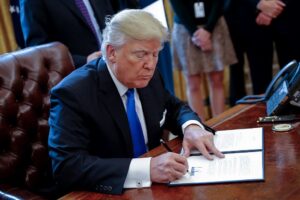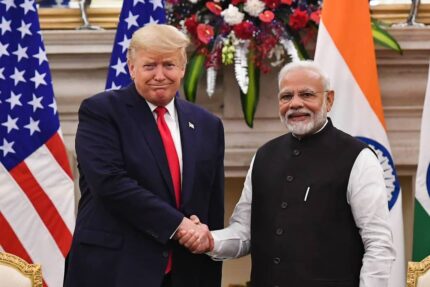India has historically undertaken major economic reforms in times of crisis. The most famous example remains the 1991 liberalization, when a balance of payments crisis forced the country to open up its economy. Today, as the U.S.-China trade war under former President Donald Trump continues to shape global commerce, India finds itself at another critical juncture.
Trump has frequently criticized India as the “tariff king,” pointing out its high trade-weighted import duties, which stand at 12%—far higher than the U.S. (2.2%), China (3%), and Japan (1.7%). Trump administration imposed tit-for-tat tariffs on several nations, disrupting global trade flows. Now, with speculation about Trump returning to power, India must decide whether to deepen its protectionist stance or embrace further liberalization.
Despite its growing services sector, India’s trade deficit remains a pressing concern. Its share of global exports stands at a mere 1.5%, and high tariffs continue to raise costs for both businesses and consumers. The big question now is whether India will seize this moment to undertake structural reforms and further integrate into the global economy.
India’s Dilemma: Reform or Retrench?
Prime Minister Narendra Modi’s government has often been criticized for its protectionist policies. Under the “Make in India” initiative, the administration prioritized capital- and technology-intensive industries, but the push has yet to significantly boost manufacturing or exports. High tariffs have fostered inefficiencies in domestic industries, discouraging competitiveness and innovation.
However, recent moves suggest a shift in policy. Ahead of Modi’s meeting with Trump, India unilaterally lowered tariffs on certain U.S. goods, including bourbon whiskey and motorcycles. Commerce Minister Piyush Goyal has also urged exporters to shed their “protectionist mindset” and compete on a global scale.
At the same time, India is actively negotiating free trade agreements (FTAs) with countries like the U.K., New Zealand, and the European Union. These deals could pave the way for more open trade policies, though they also raise concerns about foreign competition flooding the Indian market. The challenge remains whether India will take bold steps toward reform or retreat under external pressure.
The Risks of a Protectionist Approach
Economists argue that India’s inward-looking policies over the past decade have hurt its manufacturing sector. Viral Acharya, a professor at NYU Stern School of Business, warns that high tariffs have allowed “cosy incumbents” to dominate industries without meaningful competition. This has weakened India’s ability to attract foreign investment and expand its industrial base.
Rajeswari Sengupta, an economist at the Indira Gandhi Institute of Development Research, believes that India must focus on boosting exports rather than engaging in a tariff war. Unlike China, which commands a massive export base, India’s reliance on protectionism could backfire. A trade conflict could reduce India’s market access and weaken its standing in global supply chains.
Moreover, high tariffs have led to higher prices for Indian consumers. While the government justifies these tariffs as a means to protect domestic industries, they also make imported goods costlier, impacting both businesses and middle-class households. A strategic reduction in tariffs could make India more competitive while fostering efficiency in key industries.
A Unique Opportunity Amid Global Trade Shifts due to Trump Administration Tariff regime
The Trump administration’s trade policies reshaped global supply chains, and another Trump presidency could accelerate this transformation. Many companies are looking to diversify their manufacturing bases beyond China, presenting India with an opportunity to attract investment. However, experts caution that India must undertake deeper structural reforms to truly benefit from these shifts.
Trade expert Aseema Sinha of Claremont McKenna College argues that India has a “unique opportunity to shape a new vision” for global trade. By lowering barriers and strengthening ties with Southeast Asia and the Middle East, India could position itself as a key player in a re-globalized world. She emphasizes that reducing tariffs could make India a regional trade hub, drawing investments and creating much-needed jobs.
However, this path is not without challenges. A major concern is the risk of dumping—where foreign manufacturers flood the Indian market with cheap goods. Economists suggest using non-tariff measures selectively to counter this threat, particularly against China, which may look to offload surplus production amid its trade struggles with the U.S.
The Road Ahead: Will India Act?
India faces a crucial decision: should it embrace economic liberalization or continue on its protectionist path? Ajay Srivastava, founder of the Global Trade Research Initiative, warns that India risks overcompensating in its efforts to appease the U.S. If it makes excessive trade concessions without securing reciprocal benefits, it could erode its bargaining power.
On the other hand, some believe that Trump’s tariff war could serve as a catalyst for reform. Pranjul Bhandari, Chief India Economist at HSBC, argues that the shift in global supply chains presents India with a second chance. If the world looks for alternative manufacturing hubs amid a renewed trade war, India must position itself strategically to capitalize on the opportunity.
However, relying solely on services will not be enough. India must create jobs in manufacturing to absorb its large unskilled workforce. Without significant reforms in labor laws, infrastructure, and trade policy, it risks being left behind in the next wave of global economic transformation.
In the end, India must choose whether to repeat the success of its 1991 reforms or retreat into protectionism. With the global trade landscape evolving rapidly, the decisions made now will shape India’s economic future for decades to come.














